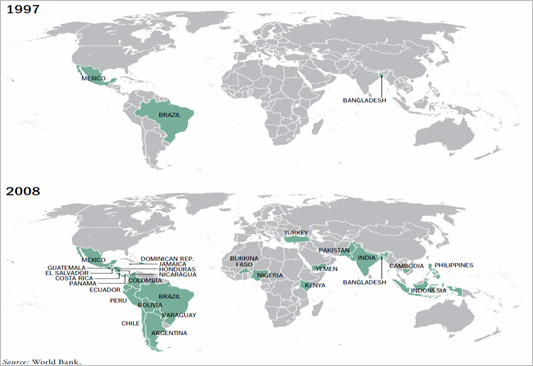Conditional Cash Transfer: An Emerging Trend in Developing Countries
|
|
November, 2010
By Shivangi Muttoo
|
In recent years, Conditional Cash Transfer programs (CCTs) have emerged as a popular policy trend in developing countries. The programme intends to provide cash subsidies to poor households on the condition that they fulfil specific requirements such as minimum attendance at school, periodic health check-ups and participation in immunization programmes. The logic behind the programme is that the provision of financial incentives will encourage poor families to fully use social services such as health and education. CCTs break the vicious cycle of intergenerational poverty and unlike traditional anti-poverty programmes, are more effective in addressing a broad range of challenges among the people living in the periphery.
CCTs were first introduced in Mexico in 1997. The country was facing severe economic and political crisis. The new regime replaced food subsidies and launched ‘Progresa’, an innovative programme for reducing poverty. Poor families were paid cash, conditional on school and health clinic attendance of their children. Brazil and Columbia implemented CCTs in the late 1990s. Gradually, the programme was included as a model of poverty alleviation in the development practices of Latin America. CCTs have been effective in increasing the school enrolment and attendance of children belonging to poor families especially girls. In addition, it had a positive impact on reducing poverty levels in some countries such as Columbia and Nicaragua.

Over the past few years, CCTs have been introduced and expanded in a number of countries in Asia, Africa and Latin America. In 1997, CCTs were run by three countries- Mexico, Brazil and Bangladesh. At present, the programme is operational in more than 28 developing countries. In terms of coverage, there has been a notable expansion of the existing programmes. For instance, Mexico started with 300,000 poor households and at present, covers more than 5 million poor households. Similarly, Brazil and Columbia have also increased the size of the programmes.
India launched the Janani Suraksha Yojana scheme in 2005 to reduce the maternal mortality rate. According to a study by Lancet- a medical journal, Uttar Pradesh and Bihar- the two poorest states of India recorded an increase in the number of women opting for institutionalised deliveries from 20% in 2005 to 50% in 2009. Indonesia introduced Program Keluarga Harapan in 2007 to improve the health and nutrition status of pregnant women and children belonging to poor households. The scheme was implemented in 7 provinces covering 400,000 poor households. By 2015, the programme is expected to benefit 6.5 million poor households across Indonesia.
Recently, Menhet-el-Ossra- CCT scheme was introduced in Egypt. Failure of subsidies in reducing poverty and the increasing rate of poverty were the main reasons to launch the programme in the rural districts of Assiut and Sohag. An average household in rural Egypt earns USD 75 per month. In addition, the family receives CCT amount USD 45 per month, more than 50% increase in the income, if the children attend school and visit health clinics regularly. In the coming years, the scheme is likely to benefit around 1.6 million children in Egypt who are estimated to experience some kind of health deprivation.
CCT is an appropriate policy response to poverty and vulnerability among children in developing countries. More than 200 million children grow up in extreme poverty. Mandatory attendance at healthcare centres and schools will help the children develop capabilities to escape poverty in their adulthood. Thus cash transfer programmes, which mainly target children, is an effective way of tackling poverty.
Basic welfare schemes, subsidies and income redistribution have largely remained ineffective in combating poverty as these are poorly targeted and fail to reach poor households. In contrast, CCTs are highly efficient as it is rule bound with specific targets. It not only provides income guarantee to extremely poor households but also builds human capital for future generations. Conditionality plays an imperative role in maximising the impact and effectiveness of the programme. In addition, the programme is economically feasible for middle and low income countries. Brazil which has the largest CCT programme spends roughly 0.44% of its GDP on the programme.
In the future, more developing countries should consider cash transfer programmes as a form of social protection to reduce poverty, inequality and social exclusion in the developing world.
Related Publications
-
.jpg&maxw=50)
Big Questions of Our time: The World Speaks, 2016
Download:Big Questions of Our time: The World Speaks _Full Report
-

-

Second Freedom South Asian Challenge 2005-2025, 2005
read more
Download:Second Freedom South Asian Challenge 2005-2025 Full Report
Related latest News
Related Conferences Reports
-

Global Challenges Conference, October 2016
Download:Global Challenges Conference Report
-

Conference on Responsibility to the Future: Business, Peace and Sustainability, June, 2008
Download:Global Security and Economy: Emerging Issues


